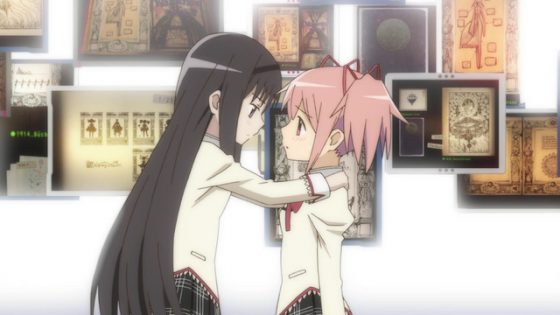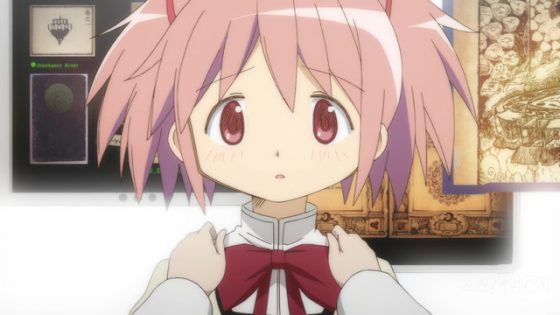
Puella Magi Madoka Magica (Mahou Shoujo Madoka Magica) is an anime original, renowned for its genre awareness, writing, and directing. It is adored globally, culminating in a movie series and a recently announced sequel. Madoka Magica has earned its praise; its attention to lighting, objects, and architecture is phenomenal, layering its story with nuance and religious symbolism.
For this article, I will be using the Netflix version of the show. By highlighting scenes and explaining elements of architecture, objects, and lighting, I want to show how Madoka Magica visually explains its core themes.
Born in Light: a City of Glass
The setting for Madoka Magica is a modern marvel. In Mitakihara City, buildings exude light as if they were born from it. Light “peers in” through glass windows, pouring over characters like a watchful deity.
This “glass city” reflects light. Its design allows others to look inward. Objects used to look at oneself are plentiful. Within the first episode, Madoka is reflected in a mirror, every angle of her face captured. In contrast, later mirrors reflect not a character’s outward appearance, but the state of a character’s “soul.” The reflections of students also appear as they walk by the water near the school, and even gigantic cathedrals exist (inner reflection), fitted with beautiful stained glass.
Everything invokes an idyllic, beautiful quality--as if the city’s soul is on display. However, this beauty is fragile. It’s beautiful in the way a snow globe is: a single moment everlasting. Once the glass breaks, so does its perfection.
When Mami, a role model and protector of the cast, dies, so does this innocent time.
Outside the Garden
Once characters lose their way, they awaken to a changed world. The light from buildings reveals their shadows. Walls that once protected innocence now separate the characters, fostering misunderstanding and paranoia. What should be a story about togetherness and emotional connection (the true magic) becomes a story about isolation and distrust.
This transition is vital to understanding Madoka Magica. Although the city has changed visually--it is not a living object. Therefore, its transformation must be attributed elsewhere: the characters. If this “glass city” reflects its characters, then when they change, the city will as well. For this reason, we need to start at the rooftop--before the “fall.”
In episode 2, the show foreshadows its plot. Sayaka comments, “I’m sure it’s not all that unusual. Wishing for something so strongly you’d gladly trade your life for it… It means the two of us who can’t even figure out what to wish for… haven’t experienced even a fraction of those people’s suffering.”
The scene takes place on the school rooftop. Starting from above, the camera lowers, revealing a peculiar marble white church. Enclosing Sayaka and Madoka are pearl white fences--a fence that exists for their safety.
This scene also takes place 24 minutes into the first Madoka movie, a retelling of the original show. In the movie, this scene has a full-blown cathedral, made in the likeness of the Cathedral of Milan, a doubling down on religious imagery and the idea of self-reflection.
After showing the building, Sayaka moves out of the shot. We eventually see her grasping the white fence surrounding the rooftop. After deliberating on why Madoka and Sayaka can’t come up with a wish, Sayaka says, “Well… Maybe the pair of us are just fools?”
The fences protect them from the outside world. Surrounded by extravagance and luxury, these characters are unaware of suffering. For them to know, these girls must walk outside these fences.
A Faustian Bargain: the Price of Knowledge
If the white fences of the rooftop protect the characters, then to walk outside them is to fall. To do so willingly seems illogical. Thus, to cross this barrier, the story provides both motivation and temptation: Mami’s death and a wish.
Sayaka admires Mami. To her, she is a role model, a hero, an icon of self-sacrifice and justice. However, the person she idolizes lives in a different world--one separate from Sayaka’s innocence. The realization of who she is--a child--starts her transition into adulthood.
Little does she know, to follow Mami is to meet the same end.
Stoked by her beliefs, Sayaka is tempted to become a magical girl. To do so, she accepts a contract under malicious conditions. At the beginning of episode 5, the visuals are not subtle. As if a ritual were taking place, a blood-red hue covers the buildings.
Atop the hospital is a garden, bathed red by the sunset. From above, several circles envelop Kyubey and Sayaka, their shadows extend ominously into the distance. The next shot is at their sides. Sayaka finds herself caged in by red fences. Upon closer inspection, Kyubey looks like he has 8 tails, the shadows around him create an imposing aura.
Kyubey’s signature closeup appears next, then a cut back to Sayaka whose shadow shifts mysteriously closer. Kyubey looms towards the camera, his ears enter Sayaka’s chest and rips out an egg-like object: her soul gem. Sayaka now descends from above. Beneath her are a bed of flowers, but before she falls the director aptly cuts away, shielding our eyes. This descent preludes her end:
A fall that’s hardly soft.
Final Thoughts

Puella Magi Madoka Magica starts off slowly, adding meaning as characters venture outwards. By observing architecture and lighting, a viewer can mold context from their surroundings, deriving a story’s direction. For the next article, I will discuss the context of “falling” and the duality of hope as shown through objects.

